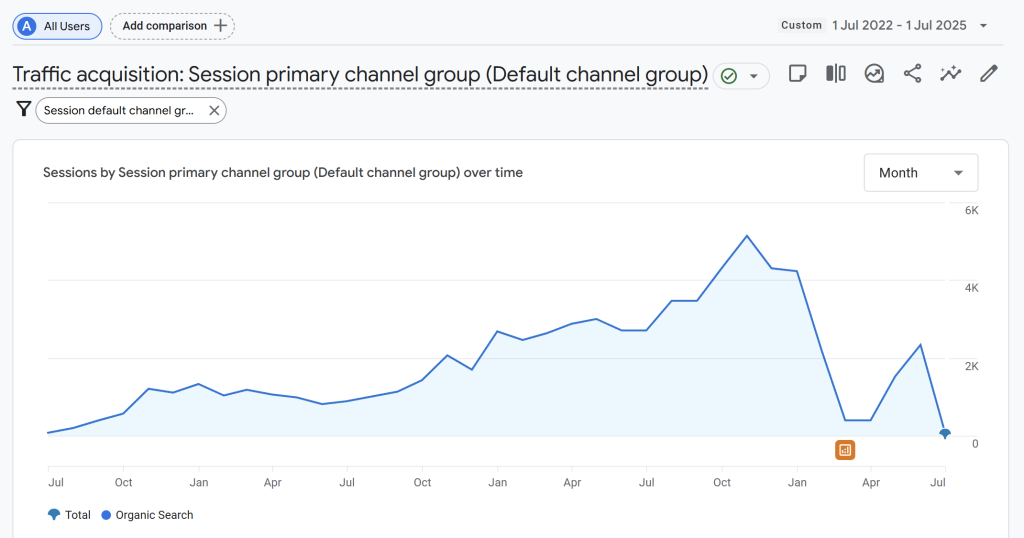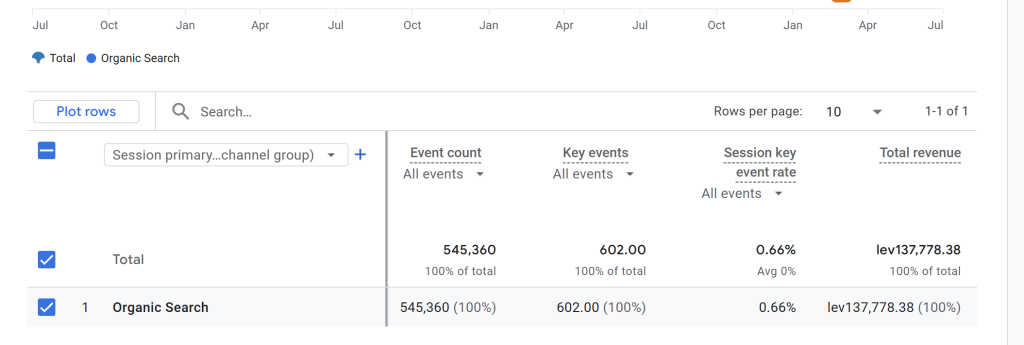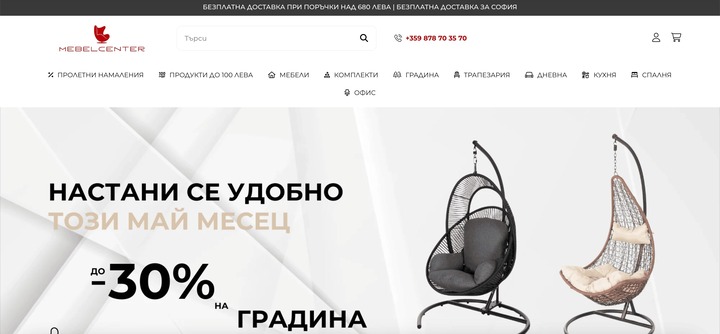When one of the founders of mebelcenter.bg reached out, the idea seemed almost too ambitious.
They wanted to grow a brand new e-commerce shop from the ground up, in a marketing dominated by large retailers with big marketing budgets.
Almost 3 years later, despite the hardship, the e-commerce shop reached 5,000 monthly organic clicks and generated 140,000 leva (approximately 70,000 EUR) in SEO-attributable revenue with virtually no SEO budget.
Here’s how we did this.

(The site experienced tracking issues at the beginning of 2025)

Topics
TL;DR
I built a brand-new e-commerce site from scratch to €70k in SEO revenue in under 3 years—with almost no budget. The secret? A strong expired domain, rock-solid technical SEO, and a smart “deep categories, flat products” structure. Skip the fancy tactics—just nail the fundamentals, and Google will reward you.
Finding a strong expired domain
When we first discussed the project, they didn’t even have a domain for the website. After a quick consultation, we established a criteria:
- Leverage existing authority: Buy an expired domain with backlinks and age.
- Budget constraints: Spend a maximum of 50 EUR for domain acquisition.
- Industry relevance: If possible, find a domain previously used in the furniture industry.
Why did we do that?
Using an expired domain allows for faster results when you’re starting out. Brand-new domains take time to build authority. Not only this, but Google keeps new domains in a “Sandbox,” which is an algorithm that holds back new domains – basically, nothing you do for the first 6 months yields strong results.
Buying an expired domain is essentially taking a shortcut over this.
After a short search, we found mebelcenter.bg
The analysis showed:
- Domain age of around 5-10 years
- A dozen backlinks from Bulgarian websites, some of them with great anchor text.
- Clean backlink profile. No toxic links or traces of spam tactics.
- Previous indexation in Google
The domain cost was just 12 EUR, well within the budget and offering great value. This gave us a great head start.

Building Technical SEO Foundation
Starting from zero when you’re in SEO is a rare opportunity to do things right from the beginning. We made sure to take advantage of it and implemented technical SEO best practices from day one.
Here’s what we implemented:
Indexation and crawling optimization:
- Implemented XML sitemaps with proper categorization
- Added a custom robots.txt file to guide crawler behavior, excluding a ton of filter pages, admin and checkout pages.
- Established a good site architecture, making sure all important pages were no further than 3 clicks from the homepage.
Preventing common e-commerce SEO pitfalls:
- Configured canonical tags to prevent duplication issues with filtered product views in the categories
- Blocked crawling of some of the non-essential parameters (color, size, sorting options) while preserving user functionality.
- Implemented pagination with rel=”next” and rel=”prev” attributes
Technical performance enhancements:
- Implemented image formats with lazy loading for product galleries
- Created a mobile-first responsive design
- Made sure the server loaded for less than 500ms and optimized the majority of product pages for optimal performance (Crucial in 2025)
- Added Product, Breadcrumbs and Organization schema markups to trigger the correct signals in the algorithm and hopefully have rich results on the SERPs
- Implement a wide range of tactics to improve internal linking as discovery tends to be a big problem when it comes to e-commerce SEO
These technical foundations proved crucial, as we were able to rank a wide variety of product pages for long-tail keywords.
This would’ve been impossible without a proper technical optimization.
With technical fundamentals in place, we switched our focus to an On-page SEO.
On-Page SEO
Another important SEO strategy in E-commerce is turning categories into “hubs for authority”.
This allows you to compete for more general keywords with higher search volumes while also creating a silo structure that allows internal linking to flow to product pages, which you then rank for long-tail keywords.
Sounds simple, right?
The image shows what an optimal structure for e-commerce shops looks like:

Deep Categories
- Implemented a silo structure with logical categorization (living room → sofas → corner sofas)
- Aligned category names with searches
- Included internal links from informational content to relevant categories
- Build a user-facing sitemap with internal links to every single category page on the website. (It feels like a cheat code)
Flat Product pages
- Created unique, detailed product descriptions, doing our best to avoid manufacturer boilerplate pages. Google rewards uniqueness.
- Listed comprehensive specifications including all dimensions, materials, and warranty information. This is important!
- Incorporated detailed delivery information specific to major Bulgarian cities
- Implemented a structured FAQ section addressing common buyer concerns
- Build a proper hierarchical heading structure and ensure titles, meta descriptions, and images are optimized for SEO. This takes effort,t but it makes a genuine difference
This “deep categories, flat products” approach allowed us to:
- Concentrate link equity on category pages that target competitive keywords
- Allow that authority to flow down to product pages through strategic internal linking (silos)
- Optimize product pages to rank for long-tail, high-conversion keywords
Content Marketing and Link Building
We didn’t do any link-building or content marketing. We added the website to a few directories, but that was about it.
The website naturally attracted some decent links, and that has been more than enough at the moment.
When it comes to content, it’s a similar story. We wrote a few blog posts that got no traction, and we chose to allocate the budget to areas where it made more sense for the business.
Continuous Optimization and Maintenance
Once the core work was done, we focused on maintenance and improving whatever we could with the budget we had at hand.
Results
Our approach delivered consistent growth over a period of close to 3 years:
- Traffic growth: From 0 to 5,000 monthly organic clicks
- SEO-Attributable Revenue: 140,000 leva = 70,000 EUR (300K total revenue)
- Keywords expansion: From ranking for 0 keywords to over 2,000 keywords
The main thing I learned from this project is that, even with a limited budget, there are still plenty of opportunities in SEO. Covering the basics gives you a fighting chance.